|
FAQs about Zoanthid Identification
5
Related Articles: Zoanthids,
Sea Mat: An
Ocean Of Color For The Aquarium by Blane Perun,
Related FAQs: Zoanthid ID
1, Zoanthid ID 2, Zoanthid ID 3, Zoanthid
ID 4, & Zoanthids, Zoanthids 2, Zoanthids 3, Zoanthid Behavior, Zoanthid Compatibility, Zoanthid Selection, Zoanthid System, Zoanthid Lighting, Zoanthid Feeding, Zoanthid Health, Zoanthid Reproduction,
|
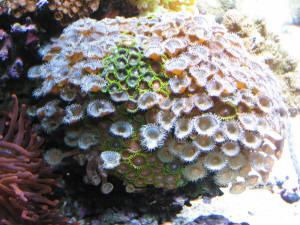
|
|
Curacao Soft Coral ID 8/4/19
Hello,
<Hey Joe>
I sent Bob an image earlier of a soft coral found in Curacao that has escaped my
ability to identify. He requested I send the image here so I have attached both
a daylight and blue spectrum photo. Cheers!
<The Zoanthid at top? Protopalythoa grandis - Giant Sun Polyp, Sun Zoanthid...
Cheers BobF>
<Oh, and per your ID on Facebook: Isaurus tuberculatus, another Zoanthid for the
organism below>
Joe Oliver
|
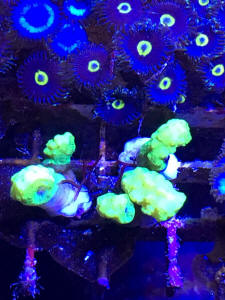
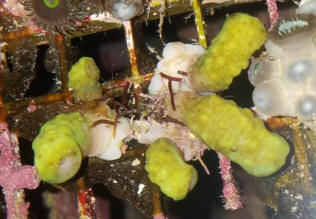 |
Zoanthid mystery; ID 9/28/13
Hello crew, I am writing again with question about Japanese coral. I
take care of both a 75 gallon Japanese species tank at home and a 265
gallon Japanese species aquarium at the small municipal zoo in my town.
Recently, a friend gave me a rock with some "Tubbs Blue" Zoanthid
<https://www.google.com/search?sourceid=navclient&aq=&oq=%22Tubbs+Blue%22+zoanthid+&ie=UTF-8&rlz=1T4GGNI_enUS553US554&q=%22Tubbs+Blue%22+zoanthid+&gs_l=hp...0i22i30l5.0.0.0.19376...........0.4a3zVrLPePQ
>
on it and it was placed in the 75 gallon tank. Zoanthids have also come
up as a potential coral for use in the 265 gallon. Thanks to a study by
Reimer, Irei, and Nozawa I have been at least able to determine that a
few species of Palythoa and Zoanthus are found in the Ryukyus.
<Yes; have seen them there>
My question is, are there any hard and fast rules to determine
species with Zoanthids?
<Hard and fast?>
I have found some rough guidelines for determining genus ( amount of
sediment in the tissue, method of attachment to the coenchyme), but so
far my search to correctly biotope-appropriate species has been
nightmarish. I know that many Protopalythoa are commonly sold and I've
yet to find any record of them found in Japan, and I would hate for a
non-Japanese species to sneak it when not absolutely necessary (such as
hermit crabs or snails as clean up crews). Should I just rehome the
Tubbs blue Zoanthids and scrap plans for Zoanthids in the 265 gallon
altogether?
<If this is a concern (as you state); yes>
I knew going in that a Japanese
endemic tank would be a challenge, but this has me stumped.
Grateful as always,
CL
<I would exclude this "Tubbs". Bob Fenner>
|
Significant Majano colony in a significant aquarium. Svc. acct.
possibilities 6/18/2013
Hi,
<Guru Steve>
First, thank you for your service to the aquarium community. The internet
has evolved to become both the best and worst source of information for
hobbyists (mostly the worst), but WetWebMedia is among a half dozen web
sites I regularly refer people to.
<Ahh!>
I have recently been asked to take over the maintenance of a salt water
aquarium in the lobby of a retirement home. It is a relatively large tank of
some 8 ft long by 30 inches tall by 24 inches deep and it has not had
professional maintenance since... well I'm not sure it ever had professional
maintenance. There is no protein skimmer, limited water movement and
although there are two individual sumps there is nothing in either of them.
All in all the tank inhabitants are surprisingly healthy.
<A challenge for sure... Enjoyable>
So the primary filtration method can be seen in the pictures, a
Majano colony.
<Mmm, don't think so... look more like Zoanthids to me>
It is not only a type of Majano I've never seen before, but it is by far
the largest colony I've ever seen. I would estimate in the 10's of 1000's of
individuals. The colony has done an excellent job of filtering the
water but I would prefer another method.
<Me too; IF this is, or can be easily made the decision of the folks there
in charge>
It seems obvious to me that tearing the tank down and rebuilding it from
scratch would be the solution but that is not practical.
<Mmm, really? Perhaps you can sell some of the animal colonized rock and use
the proceeds to upgrade here>
The custom cabinetry does not allow for easy access and the area of the
install does not allow for a mess to be made.
<... Sorry; I'm not easily convinced of this... having spent a few decades
doing this work...>
Further, I fear that if I suggest to the management we do a full tear
down/rebuild they will simply remove the tank and replace it with
bookshelves and a nice painting. Even removing the rock and replacing
it would not likely go over well with management as the aquarium is a wall
divider in a very high traffic area in between their central common area and
their dining room and.
<Mmm, perhaps the work could/can be done during the night, early AM, when
folks there wouldn't be disturbed?>
This is a paying job so I'd like the tank to stay of course but I would also
like to make this a show piece for the retirement home and I am willing to
donate some of my time to accomplish this. I'm not looking for advice
regarding the filtration of the system but rather specifically how to handle
the Majanos. What would you do under these circumstances? The last guy they
hired simply never returned :D
<Heeeee! I would at the least, do the upgrade slowly, surely, perhaps on the
sly... removing the colonized rock regularly, and changing the system to
what you deem is best for this customer. The approach I'd take is to present
this as the low end option, and a higher-est one to management there,
detailing what you'd do given a free hand, pocket book... for them, and the
rationale (provide better water quality, be able to add more interesting
life for their clients...)>
The pictures tell the story. There are two massive colonies at each end of
the tank that are now meeting in the middle where the 25 to 30lb clam sits.
Everything that looks brown and soft in the picture of the full tank is
Majanos. The 2nd picture shows one of the colonies and the close up is
a rock back at my shop under my lights.
2013-06-14-03-35-36-0206.jpg2013-06-06 06-59-47 - 0190.jpg2013-06-0606-58-11
- 0176.jpg
Yours Truly
Steve White
<Thank you for sharing. Bob Fenner>
Quinte Reef Systems
www.quintereef.ca
|
.jpg)
.jpg)
.jpg) |
|
Hi can you help me out please. 11/22/12
Hi
<Hello Grant>
this is my first saltwater aquarium I've had it for 5 days it's 400 liters
and roughly 20-30 liter sump running a skimmer and heaters to 24 degrees
(Celsius). Yesterday I added live rock after achieving a 1.024
salinity<Specific Gravity> and was wondering what is happening on them i.e.:
good or bad.
I'll attach 2 pics and hopefully get some answers, after searching the web I
candidate find any info on what I'm describing or am possibly phrasing it
wrong.
Is the first picture coral or something else?
<Palythoa, "good".
http://www.wetwebmedia.com/zoanthid.htm >
On the second picture are these pods/bulbs good or bad the seem to be
appearing really fast.
<Bubble algae, "bad".
http://www.wetwebmedia.com/BubbleAlgCont.htm >
My live rock has only been in the tank 24 hours. My water readings are as
follows pH.=8.2 k.h=196.9 ammonia=0.50 nitrate and nitrite
are zero calcium=380 and phosphate=0.25
Any help will be appreciated.
Thanks Grant.
<Jordan>
|
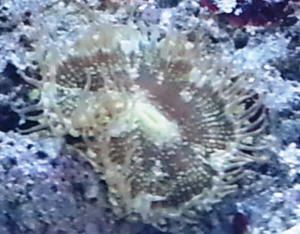
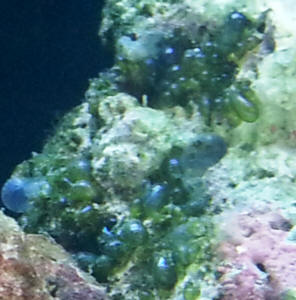 |
|
id of possible anemone needed 9/10/12
Hi there. I hope you guys can help me with my query. I am based in U.K
and have a 240l soft coral reef tank. I recently bought a small rock
with a small colony of yellow polyps on it, amongst the polyps I spotted
several lime green polyp type growths ranging in size from the largest
at approx 0.5cm to the smallest which are not much bigger than a
pinhead.
<Mmm, do you mean mm? Not likely, but half a centimeter is about a fifth
of an inch... not a pinhead>
unfortunately over the last couple of months due to ill health I was
unable to care for my tank and the yellow polyps just faded away and
disappeared leaving an empty rock except for these unidentified polyps.
one thing I noticed was sometimes the rock appeared devoid of anything
on it so they can obviously retract into the rock which got me wondering
what these things were so I posted in the Forum that I'm a member of and
I was told they thought it was a nuisance anemone possibly mojano,
<Mmm, no; don't think so>
now when I first acquired my live rock 16 months ago I had a
couple of mojanos on a rock which were correctly identified to me and by
searching the net I was able to confirm this is what they were, these
new ones look nothing like a mojano to me but more resemble a Zoanthid
<I agree. Umm, read here:
http://www.wetwebmedia.com/zoanthid.htm>
or Palythoa except for this retracting behaviour.
<Zoanthids can contract>
I have searched the net looking for information but cant find anything to
give me a definite identification, although rock flower anemones also
seem to get mentioned in the same breath as mojano. I find these small "whatevers"
to be quite attractive but having been told they could become a nuisance
I'm undecided on what to do, as yet I don't have a sump that I can
remove them to. I have attached the best picture that I have been able
to get of the biggest one. Really hope you can help me with
this................Kevin
<A beauty. And I do concur w/ your assessment; but would keep them. Bob
Fenner>
|
 |
Re: id of possible anemone needed
9/10/12
Wow Bob!!!
Thanks for the very fast reply, I'm really impressed just to
clear up on a couple of things, the picture is of the largest "polyp" and
this one is about 1/2 cm in diameter the others are at the moment much
smaller and about the size of the head of a pin., also you mentioned that
Zoas can contract and I understand this I have Zoas in the tank that close
up, contract if you like but these new things actually retract back into
holes in the rock and it was this behaviour that actually alerted me to the
possibility of an anemone. do any Zoas/palys ever fully retract in this
manner?
<Mmm, yes; depends on species... how they're situated in the kind of
substrate>
I have never kept a nem and have almost zero knowledge concerning them but
have in the past like most aquarists suffered with mojano <Majano> and
Aiptasia so I'm a little worried about the possibility of these things
taking over. once again thank you for the very speedy response. WetWebMedia
is definitely going into my favourite web sites. so glad i stumbled across
this site
<Me too. BobF> |
|
Polyp identification 8/5/12
Hello there WWM crew. I have had this group of polyps for over a year now
but have watched them grow for years on a friends tank. They do not seem
aggressive as they are growing in a few areas of my tank with no damage to
date. What I would like to know is what are they?
<I do think this/these are some sort of Zoanthids>
Largest polyps are around 3 in, they have buds not tentacles and split
rapidly. Please let me know where they are from, scientific name, common
names, and reference to a care sheet if possible. I have searched many ways
to find out what it is and have shared frags and am sure all of us would
like to know. Thank too very much for your help
<Please read here:
http://www.wetwebmedia.com/zoanthid.htm
and the linked files above. Bob Fenner>
|
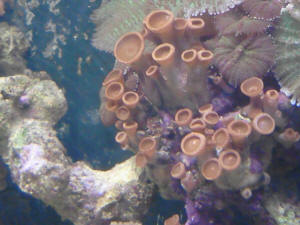
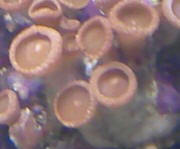 crop
crop |
|
Re: Polyp identification
8/6/12
Thank you for that....I figured it was a type of Zoanthid, but do you
know what type it is?
<Not from this pic, no. Have you read on WWM re Zoa ID?>
Or if not can you point me in the right direction of where to find out?
<... already have>
I have been in the hobby for many years and have never seen any quite like
these before. I have in my research found one picture via Google search
(and of course can't find it again but they were trying to find out as
well with no avail, the closest they got was an "I think its from the
Florida keys". I have had allot of luck with your site as yours I'd by
far the most in depth please if you can help me to identify this
beautiful piece I would greatly
appreciate it.
<Look, grow very differently depending on light, nutrition, water
quality.
B>
Re: Polyp identification 8/6/12
Yes I read the id page and while very interesting they are not on there.
I don't believe they are actively sold so unless I can find a large list
of Zoas I probably will never know exactly what they are. I have called
them cup polyps for years so that will suffice. Thank you again
<Mmm, well, these are very likely "recruits"... most probably from live
rock... survivors. Hard to distinguish anything lower than genus level
macroscopically. B>
|
|
Mystery coral 3/31/12
Hi all,
<Good Morning Edith>
I have a question about a hitchhiker coral polyp that I have not
been able to find information on anywhere! When I found a
possible ID in a book and typed in the scientific name on Google,
the response was "nothing". I'll attach a photo to
this email and give you the name I found in Julian Sprung's
"Corals, A Quick Reference Guide", which was Chadocora,
and maybe caespitosa. Other than one small photo, there was no
information on the coral, and I don't know if that was the
correct picture.
<The picture appears to be of a type of Zoanthid or Palythoa.
Review the following link and see if it appears to be the same
for you.
http://www.wetwebmedia.com/CnidIndex2.htm>
The live rock had been in my 90 g. reef & fish tank for about
three years, and the coral had remained very small and barely
noticeable. I installed an LED light about 6 months ago and have
made a point of target feeding the coral and it is now slowly
multiplying, although the little ones around it can't be seen
in the photo. The coral (polyp?) is now about 1-1/2 inches
across. I'd really appreciate some help on this since every
new arrival, even a hitchhiker is fascinating!
Thanks for all your help in the past. I don't know what I
would do without you!
<You are welcome! Bobby>
Edie
|
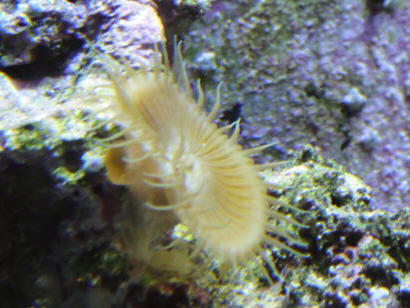 |
|
Coral ID 3/4/12
Please ID, thanks.
<Paul, easily found on our site, please learn to use the
search tool. Your corals appear to be Faviids,
Caulastrea. See, scroll down here.
http://www.wetwebmedia.com/faviidae.htm
James (Salty Dog)>
|
|
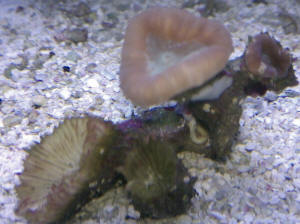 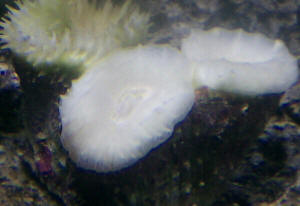
|
|
Re Hitchhiker ID 3/5/12
I of course use the search tool on your website, it's the
only reason I haven't asked more questions. If you
prefer I can seek my answers elsewhere, but I don't trust
other sources half as much.
<Was not aware you have searched the site.>
So, hopefully you'll indulge me once more, and only
because hours of searching your site and others have not revealed
what these creatures are. I thought they were sponges, but
they glow slightly in the center of the discs at the top.
They are also pushed slightly in the current. And I have
not seen any tentacles.
<I wish you would have replied to the original thread.
If I recall correctly, the original thread was coral ID,
Faviids. If you are referring to the 8-10 brownish polyps
in this attachment, they appear to be solitary
Zoanthids. There are three growth forms of
Zoanthids, solitary, connected (polyps joined by the stolon), or
massive (polyps embedded in coenenchyme). I cannot blow the
picture up very much without excessive pixelization. A
close up may provide a more accurate ID. If there is
chemical allelopathy going on in your system, the tentacles may
not fully extend.
Bob may also comment on the ID here.>
Thanks for the answers.
<You're welcome. James (Salty Dog)>
|
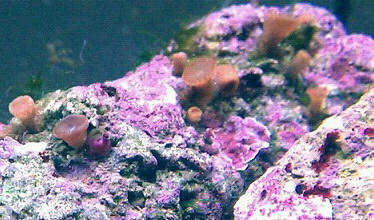 |
Re Hitchhiker ID 3/5/12
Thank you,
<Welcome>
it's exciting to get new creatures without knowing it,
WWM is a great site full of info which I consume daily. These
brown guys are different from the original thread, 'tis why I
didn't respond to that thread.
<I see but you could have, was still coral ID.>
I tried feeding them Mysis shrimp and they ate the shrimp! I
have been staring at them quite awhile today, and I think a saw
very tiny tentacles less then 1mm... and I also noticed when they
close up they look like baseball bats with a hole in the top.
Do you think the ones that stay closed most or all of the time are
in decline (there are only a few small ones staying closed)?
<Mmm, all depends on other Cnidarians present as I mentioned
before, may be some allelopathy going on....other Zoas, mushrooms,
etc. May be lighting, too strong, not strong enough, too much
water flow. Best to search/read Zoanthids.>
Thanks again.
<You're welcome. James (Salty Dog)> |
|
Identification required 9/1/11
Hi,
<Hello>
I have used your site extensively, but could not find the species
I have received as present. Thanks for a great site.
I would like to identify the coral in the image attached.
Kindest Regards
RENIER HUGO
<This appears to be a Zoanthid, likely of the genus Palythoa.
DO make sure and wash your hands after they've been in
contact w/ this animal/colony, or even just the system water. DO
read here re:
http://wetwebmedia.com/ZoCompF2.htm
Bob Fenner>
|
|
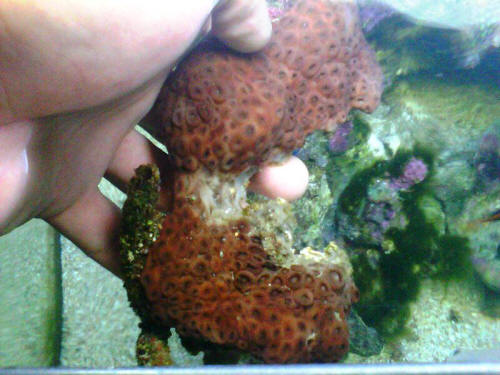
Re: Identification required 9/2/11
Hi Bob,
<RH>
Thanks very much for the reply. Would you recommend I remove this
coral altogether? After reading the posts on the website, I
gathered that they can turn into a pest due to their aggressive
nature/poison.
<A possibility>
I keep lots of other zoa's, buttons, cloves etc, fish,
bristle stars etc and as far as I am aware they are pretty
safe?
<Maybe... the fact that you have the other Zoanthids... you
may be fine>
My questions really: They are not the prettiest, should I
"bin" them?
<I'd at the very least slowly acclimate each to each
through mixing water back and forth in separate systems for a few
weeks>
Regards
Renier
<And you, BobF>
|
|
Mystery coral ID? 8/8/11
Good afternoon!
<Susan>
You have been my best resource for the last nine months. Just
before Christmas last year I received a new 60-gallon system
which - thanks in no small part to you - is thriving. It's a
dedicated seahorse/soft-coral system, which cycled for 3 months
with inverts (coco worms, snails, cleaner shrimp) before I added
the first corals or fish, and then I added corals very slowly
<Good>
and all from a single source (a local coral breeder/dealer),
compatibility-matched using your site and seahorse.org to ensure
incompatibility and health.
<Very good>
Dips, quarantines, and other solid measures are in place. A pair
of seahorses came in on June 10 (six months almost to the day
after the tank started running). Other fish tankmates are one
banded pipefish, one scooter blenny (pictured with coral) one
very fat green-spotted dragonet (the dragonets eat frozen mysis,
though I add tigger pods weekly also - this one has more than
doubled in size in the time I've had him - thanks in no small
part to reading on your site about his needs), one yellow
watchman goby and two blue neon gobies.
Invert population is one tuxedo urchin, one Staghorn hermit, six
coco worms, two feather duster worms, two skunk cleaners, three
peppermint shrimp (true peppermints), five very small mexican
red-legged hermits and a "janitorial squad" of trochus,
Nassarius, and Cerith snails.
The inn is full, and that's all I'm intending to add.
Everything is healthy, eating and growing.
<Ah, good>
I can't tell you how lucky I was to find you guys in advance.
I've learned from so many others' mistakes and...yes, I
read before I bring things home.
Tanks, like pregnancies, are better planned!
<Agreed>
But like everyone else, I succumbed to the "this looks
awesome, I think I will take it" syndrome with a coral. (I
can hear you shuddering from here.)
The coral breeder/LFS owner said he's seen thousands of
corals in his years in the business, but couldn't identify
this. He had put it in his own system to test it and see if it
stings (it didn't appear to) or was aggressive (it didn't
appear to be) and he thought I might like it. He also knows my
system is invertebrate-friendly and doesn't house many things
that could harm this.
So yeah, I brought it home. Photo is attached. It's been in
the tank 2 months with no issues. It's growing well
(isolated, as you can see, on its own piece of live rock in the
sand bed where it can't get into too much trouble. The photo
is a little blurred (sorry) but I included the scooter blenny for
size comparison. The photo is true-color. The coral's mouths
are open pretty much all the time except when it feeds. It seems
to filter feed from the water (I feed a combination of live
phyto/oyster feast/rotifers for the corals) and also loves mysis
(I feed frozen Hikari mysis/SF Bay Brand Omega enriched frozen
brine to the mandarin/scooter blenny and seahorses).
My question is..what the heck is it?
<A Zoanthid>
I've done hours of research but can't find a good photo
match to it anywhere, so I thought I'd send it along and see
if you guys know what it is I'm dealing with - partly because
if it's going to grow up into a fish-eater, I'd like to
know while I still have time to re-home it. The LFS owner/coral
breeder said he'd gladly take it back any time I don't
want it any more, so it has a good home either way.
Thanks in advance for your help and for the amazing resource you
provide.
I guarantee my tank would not be the success story it is without
WetWebMedia.
Susan Spann
<Please read here: http://wetwebmedia.com/zoanthid.htm
and the linked FAQs file above re this group's
Compatibility... There are some aspects of their biology you
should be aware of. Bob Fenner>
|
|
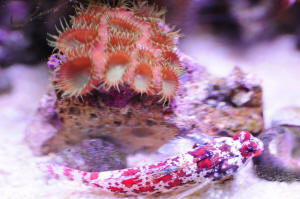
|
|
Re: Mystery coral ID?
8/9/11
Thank you very much Bob (and Company!),
<Welcome!>
I was delighted to see that this is apparently a (weird)
Zoanthid. My tank is very Zoanthid-friendly, and
though I won't move this one near any of the more
standard-looking varieties I think it will continue to get along
very well here. Thank you again for your help!
PS - I promise never to do the "ooh neat!" thing again.
It's too much stress!
<Heeeee! A common human trait... I often think that our
attentiveness to "new, shiny things" is likely a
positive trait, accounts for our apparent progress... Cheers,
BobF>
Re: Mystery coral ID? 8/9/11
One last email to thank you guys a final time. After reading
everything I could find on your Zoanthid pages (again...I have
some other Zoanthid/Palythoa species in the same tank) I've
finally identified the little guy! Palythoa
caesia -
<Ah yes>
I found images on the 'web that match mine exactly. Thank you
so much! (Incidentally, this also explains why it likes being
target fed frozen mysis along with the standard
phyto/oysterfeast/rotifer combination I feed the tank).
Thanks a ton! I don't think I ever would have found it
without you!
Susan Spann
<Cheers again. B>
|
|
Colonial Anemone/Parazoanthus? 12/22/10
Hi Crew,
<Howdy Jim>
So far I have had my tank (29G reef) set up for about a year now.
Despite some algae and pH problems which I'm working to get
in-line everything seems to be doing well. I have used your site
for a reference for the past year and so far it has been a great
resource and I haven't had to ask any questions directly up
until now (thanks!).
<Welcome!>
It seems that every week or so I still notice something new in
the tank.
Lately I have seen 3 colonies of these "polyps" in my
tank. From some research on your site and elsewhere, the only
conclusion I can come up is that they are some kind colonial
anemone or Parazoanthus.
<Mmm, am pretty sure these are Aiptasiids... the family of
Glass Anemones.
Please see here:
http://wetwebmedia.com/marine/inverts/cnidaria/anthozoa/aiptasia/aiptasiaidfaqs.htm>
They don't seem to respond to changes in light like a tube
worm, although when I prod them with an object they seem retract
into their rigid tube. They are only a few mm wide and long.
<Oh! Small thus far>
Do you believe these will become a problem if they start
spreading throughout the tank?
<Could be if they begin to squeeze out other life, perhaps
stinging your livestock>
Should I remove them, or just monitor them for now?
<If not too numerous... I'd just watch/see. Do see the
related links above the citation re controls of various
sorts>
Please see attached photo.
Thanks,
Jim
<Welcome and happy holidays. Bob Fenner>
|
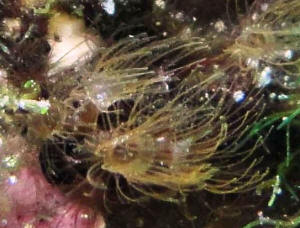 |
Re: Colonial Anemone/Parazoanthus?
12/22/10
Hi Bob,
<Hello again Jim>
Thanks for the prompt response! I had thought they might be
Aiptasia at first, but from my research I thought I remember
reading somewhere that these creatures don't retract into a
tube, but when they retract, they usually retract their whole body
into hiding (making them hard to get at).
<Yes and yes>
The ones in my tank definitely leave a visible tube behind after
retracting so it is the only thing that made me doubt they were
Aiptasia.
<Me too if so>
I will monitor and take action if necessary.
<Okay!>
By the way I have a copy of your Conscientious Marine Aquarist and
found it also to be a great resource. I wish I would have just
followed your advice from the book regarding the size of the setup.
I think a larger tank would have just been easier from the
beginning (despite the objections from the wife!).
<Heeee! Woulda coulda shoulda. Perhaps a "trade of
sorts" w/ your spouse.
Is she opining re something she'd like...?>
Happy Holidays and thanks again,
Jim
<Oh Jim! These may well be Hydrozoans/Hydropolyps based on
morphology, size, tube-dwelling habit and withdrawing behavior.
And to you and yours. Cheers, BobF>
Re: Colonial Anemone/Parazoanthus? 12/22/10
I hope not!
<Heeee! If fishes were wishes, we'd all have full
tanks!>
I even thought about Hydroids; I just wasn't aware that they
also could withdraw into a tube. They are definitely colonial in
nature and so far I see three colonies in the tank, with this and
another appearing most recently. The third has been around for at
least two months and has about 12 members.
<Mmm, but not in one patch/batch...>
For what it's worth, I was taking a look at them again and I
noticed some worms and even my peppermint shrimp touching the
polyps (causing the polyps to retract) and none of the animals
involved seemed to recoil in pain.
<Good>
They also don't seem to be connected like I have noticed in
some other hydroid pictures but I'm not sure if this is a
prerequisite or not.
<Solitary Zoanthids are rare>
I only came to the conclusion that it might be some kind of
Parazoanthus because the tentacles seemed to be long and
"stringy" as compared with some of the other pictures
I've seen of that genus. Then again many Hydroids seem to share
this trait as well.
<Yes>
I will definitely keep an eye on them. Thanks again. You and your
crew do an awesome job.
Jim
<Glad to share. BobF> |
|
Diatom/BGA question and polyp ID 12/21/10
Hello crew!
<Howsit Chris?>
My name is Chris, and I started my first marine reef tank this
past October (my 30th birthday present from my wife). All is
going fairly well, but I do have two questions. So first off, my
set-up:
65g tank, containing about 36g Instant Oceans salt water premixed
with RO/DI at my local supplier, 20% weekly changes, 110LBS live
rock (mostly Fiji with a bit of Haiti), 60LBS CaribSea "live
sand" on top of 60LBS crushed coral/stone making a sandbed
ranging 4-6" deep (depending on flow). No sump (yet, will
add in new year)
Red Sea Berlin skimmer (rated to 250g) with Mag pump @550gph,
Eheim classic 2213 canister filled with Eheim Substrat Pro and LR
crumbles, floss on the intake replaced weekly, @116gph. Hydor
Koralia (pre-evolution) 850gph fan, Hydor Nano 240 gph fan,
MaxiJet 600 @160gph. Total flow in the tank is 1916gph.
Livestock 2 percula clowns, 2 cleaner shrimp, 2 blue-leg hermits,
1 stand-sifting star, 14 Astrea snails, 6 turbo snails, assorted
small dusters, hitch-hiker clams (rock boring I think), wormy
dudes. Small frag of Orange Polyps (will ask about these in a
moment).
Tank "cycled" if you could call it that remarkably
quickly. Like, I never actually saw an Ammonia spike. For three
days my Nitrites were "up" (1.0, 0.50, 0.25), but both
have been flat at zero since. Various and sundry people kept
telling me to wait, it would spike, but after four weeks I
figured I was safe and bought the clowns. They've been fine.
40 LBS of the live rock was uncured, but the other 70LBS was
bought out of two different established (I think both about 4
years old) hobbyist aquariums near-by.
One person said it was reasonable, because there is so much rock
and sand, that my cycle was likely just really really quick
(agree?).
<Yes>
I check Ammonia, Nitrite, Nitrate, pH, SG and Phosphates 3 times
per week, and KH Ca once per week. Using API test kits.
Ammonia/Nitrite never budge off 0, Nitrate bounces between about
5-20ppm leading up to water-change day.
Phosphates go between 0-0.25ppm, but I'm told that's not
hugely accurate.
SG is nearly always pegged at 1.023, temp never seems beyond
83.2-83.9F.
KH stays around 13dKH, Ca at around 450ppm. Oh and pH is always
between 8.1-8.3
Lighting is a Marineland double strip LED (24x1watt diodes with
12 moonlights), one 50/50 Coralife t8 that came with the tank and
a 6500k PC.
I'm planning to move to all LED in the next year, before I
get into corals.
Lighting runs full for 12 hours, moonlights for 24 hours.
I've been feeding the clowns on flaked veggie food, three
times per day (which I thought was a lot, but was on advice from
place I bought them.
They eat vigorously every time, as do the shrimp (doing their
little back-stroke) is this too much?), and started feeding the
polyps 3x weekly using Kent Zooplankton (5ml per feeding,
obviously the shrimp and clowns get some too, despite feeding
directly. The polyps all close, so I assume they're
eating).
Okay, first question, I've attached a picture of the polyps.
They guy who I got them off of said they were Orange Star Polyps.
I'm not so sure. Best I've been able to find searching
here and online would be Orange Sun Polyps, but I'm not sold.
What do you think? Also, I've heard both sides, that they do
feed off photosynthesis and that they don't. What say you? Is
5ml zoo 3 times per week sufficient feeding?
<Zoanthids of some sort and feeding okay>
Second, I've had some algae, that I know isn't algae.
<BGA, Cyanobacteria>
Different people have told me it's either Cyano or Diatoms.
I've looked at various pictures and can't decide,
there's some in the polyp pic, as well as in the other pic
I've attached. As you can see, it ranges from crimson red to
brown to grey/black. It definitely prefers areas of less flow, it
grows on both the glass and LR, but especially on LR where there
is healthy purple coraline algae. I generally siphon it off
during the water changes, but it keeps coming back. When I
thought it was diatoms, I assumed "just wait", but
it's been present now for about 6 weeks. Nothing eats it,
though the snails do push it away to eat under it, so it gets
dislodged. Is it diatoms and I just need to be patient, or BGA,
and I'm overfeeding (it's been present since before I got
livestock and started any feeding)? I'm also considering
putting an ounce or so of activated charcoal in a pouch in the
canister for a few weeks, might this help?
<Mmm, there are a few approaches to consider...>
Thanks so much for such a great resource!
Chris
<Please read here: http://wetwebmedia.com/bluegralgae.htm
and the linked files above... What elements of what you
read/discern are at play here? Bob Fenner>
Re: Diatom/BGA question and polyp ID
12/21/10
A little follow-up: The polyps: Orange Zoanthids?
<Mmm, yes. Zoanthideans: http://wetwebmedia.com/zoanthid.htm
BobF>
|
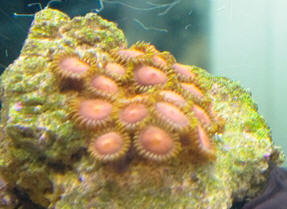 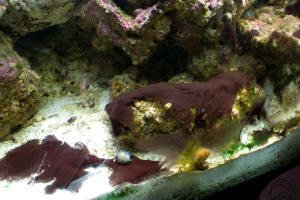 |
Re: Diatom/BGA question and polyp ID
12/22/10
Good Morning Bob (et al)
<Christopher>
Thanks for the reply and the reference. Here's my plan of
attack:
- I'm going to add 3 tbsp activated carbon in a media bag to my
Eheim
<Mmm, I'd add a bunch more... likely a "unit"
(bag) of Chemipure or equivalent>
- I'm going to cut back feeding to twice daily
- I'm going to get a timer for my lights (up till now it's
been done by hand, but we're going away for the weekend for new
year's so I had to get to this anyways). There's definitely
been days when the photo period would have been 14-16 hours if I
was working late and forgot to switch them off on time. Full lights
will only be on for 12 hours. Moonlights over night.
- I'm going to keep on siphoning off any that pops up
Thanks so much, I really appreciate how friendly and helpful you
all are.
Chris
<Welcome and please do consider the addition of a DSB in a
lighted refugium... macro-algal culture there, on a RDP light
regimen. Cheers! BobF> |
|
Emerald crab eating soft coral picture
9/17/10
Hi guys,
<Pete>
I do not have any questions for you today (its a wonder!) but I
did snap a picture of an emerald crab hitchhiker eating one of my
zoas.
<That little bugaboo! Caught in the act!>
I had this hitchhiker in my tank for a longer time than my mantis
shrimp but figured he would be food for the mantis (when it was
added) so I never really bothered to fish him out. After adding
the mantis, I didn't see much of him so I figured the crab
was breakfast already. Today, to my surprise, he was out in the
open munching on my newly added zoa frag that I had just added
about 10 minutes ago.
Guess he liked the colors so much on that one he finally went out
of hiding to eat it. I never had any evidence of him eating
softies before.
<Mmm, Zoanthids aren't Alcyonaceans (Soft Corals)>
I guess now I know the reason why my LR coralline algae was
"bleaching." I always thought it was my lights.
He's in my FOWLR tank now with my other emerald. Guess he
could help my other aquarium stay clean without eating my
softies.
<Have oft mentioned that Mithraculus species are largely
misunderstood...
are not "cleaner uppers", but eater uppers like most
decapods>
Anyways, I figured you guys might like the picture and may want
to use it for future reference when people ask about emeralds
eating softies and other reef
compatibility issues.
Happy reefing!
Peter T
<And you, Bob Fenner>
|
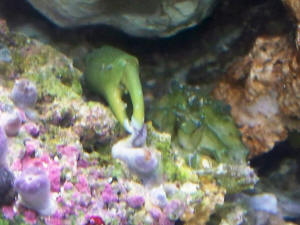 |
|
Re: Emerald crab eating soft coral picture
9/17/10
Mr. Fenner,
<Just Bob please Pete>
Thanks for correcting me on zoas not being "soft"
corals. I see them marketed under soft corals so many times I
fall into the habit of terming them softies =D
Peter
<Ahh, no big deal... Cheers, BobF>
|
|
ID of a nem? 3/31/10
Hi, I have this nem & no one on the forums I belong to has
correctly identified it. Was wondering if any of you guys could.
It came as a hitchhiker about the size of a dime 7 months ago.
Now it is as big around as a baseball almost fully cover that
whole piece. Thanks for your help.
--
Michelle
Would you please send along a larger image... maybe 300 dpi,
500kbytes or so?
ID of a nem? 3/31/10
Hi, I have this nem & no one on the forums I belong to has
correctly identified it. Was wondering if any of you guys could.
It came as a hitchhiker about the size of a dime 7 months ago.
Now it is as big around as a baseball
<!?>
almost fully cover that whole piece. Thanks for your help.
--
Michelle
<This looks to be a Zoanthid... not an Actinarian/Anemone...
Please read here: http://wetwebmedia.com/zoanthid.htm
Unusual that it's so large though. Bob Fenner>
Re: ID of a nem? 3/31/10
ok I am camera illiterate, so I attached a photo bucket link.
maybe that will help. I'm sure its a nem, not a Zoa. I feed
it 2 jumbo Mysis every other day. Its a pig, oh and has a
mouth.
http://s479.photobucket.com/albums/rr152/michelle9491/?action=view¤t=005-11.jpg
<... this is a pic that includes a colony of an Octocoral...
is it the polyp in the upper left you're interested
in?>
http://s479.photobucket.com/albums/rr152/michelle9491/?action=view¤t=002-15.jpg
Hope this helps! Thanks
<... Please see where you were referred to... this
macroscopically is a Zoanthid. BobF>
|
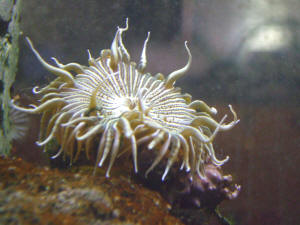 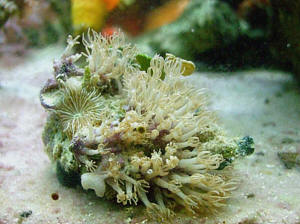 |
|
Re Reef tank, Duncanopsammia prop.
3/25/10
Hello again Simon,
<Hello Eric>
I hope I've done this right as I'm not the most computer
savvy...
<Yes, just fine>
I had the question about the Duncan coral propagation after I
found about 9 tiny heads growing under the fragment of mushroom
coral I bought... Well here is the pic, hope it sent.
<Got it!>
It looks EXACTLY, like every picture I've looked at of them.
From colour pattern to centre feeding apparatus to the stalk.
<Ok, but the polyps here are retracted. Have they come out at
all?>
Only exception is they are smaller and the tentacles are shorter,
I'm sure because they are young.
<Ok>
Any ways, if you think they may not be Duncans for any reason let
me know and I will take appropriate steps regardless.
<Because you can't see the polyps, these photos alone
would not confirm it to me, but coupled with your description I
can believe it. This is very lucky, as this is a quite wonderful
coral in just about every regard, best of all that it is very
hardy indeed. The thing that is worrying me is that the polyps
are not 'out'. This means that 'summat is up',
probably water quality>.
So. That's them under the green "mush" cap there
are four there and five more on the other side. It also appears
two more are spouting or branching off of one of the larger
tubes, unfortunately you cannot see them due to the low
resolution of the picture. They are hiding in there tubes
unfortunately I don't have time for them to open as I have
an
appointment...
<So they have opened before? Good if so.>
I also wanted to know where to get the putty and when I attach
them do I do it above water ???
<This can be done in or out of the water.. best done out if
you can, but the putty does work fine 'in-tank'. Do be
warned not to use too much at a time if you do though, it can
irritate corals if you use too much in the system. As for where,
look on the web.. search Google.. 'Milliput'. But have
you considered removing the mushroom instead? I think this might
be a better option, if these are growing out from all sides of
that small piece I would be loath to remove them for the sake of
a single Corallimorph>
If so how long can they be out of the water.
<Ooo, a good amount of time'¦ easily enough to do
the job. As long as you keep the coral moist the whole time, you
can have it out of the water for hours, but the job really should
only take a few minutes. I do implore you to purchase Anthony
C's 'book of coral propagation'.. an excellent book,
and covers a lot more ground than the title suggests. Or try here
for some techniques: http://reefkeeping.com/issues/2006-11/fotm/index.php
Fragging Duncanopsammia is identical to branching Euphyllia, but
the skeletons on Duncans are a bit more dense, so it does take a
little more work. Simon>
Re: Reef tank, fragging 3/25/10
<Hi Eric!>
Thanks again for the timely response ..
<No problem>
And yes they are most definitely open and stay out most of the
time.
<That's good then>
Even as I left they had opened more then in the pic I sent so I
guess when I get home I will take a look to formulate a plan of
action as to whether I'm going to move the mush or the
Duncans... If I have more questions I'll get back to you as
I'm fairly new to this..
<Ok, no problem>
Although I am a little worried now that you mentioned them not
being open I've read they are more active at night is this
correct...
<Not in my aquarium they are not. Most definitely open during
the day and about half-retracted at night>
And what would be some early warning signs of sickness or
stress...
<Polyps not opening will be the first sign. You are aware that
this is a Scleractinian coral and so will require maintenance of
Ca, Mg & Alkalinity? Read here:
http://www.wetwebmedia.com/calcalkmar.htm>
Ps if you don't mind I will send a pic of them open when I
get home let me now if that's ok as I'm sure you are
busy.
<This is fine Eric, send whatever pictures you like (of the
coral that is!). Simon>
Re: Reef tank, fragging 3/25/10
<Hi Eric>
Here is a pic of the "Duncans" I hope it is clear
enough for a positive ID.
<Not really.. these look more like Zoanthids to me here.. are
you sure these have a hard skeleton? Try here:
http://www.wetwebmedia.com/zoanthid.htm>
Although from what you've told me I'm 99.7% sure
that's what they are. And they do, like you said seem to be
more active during the day. I just thought I'd ask just in
case... so please ID for me if possible, and I'd like to say
"I know every one says it" that you and the rest of the
crew are the apex of timely, intelligent helpfulness. so for that
I commend you,
<Thanks!>
Thanks again Eric
<No problem, Simon>
|
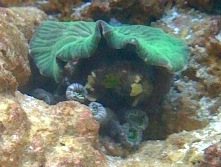 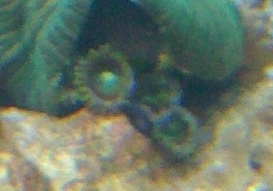 |
Re: Reef tank, fragging
3/25/10
Yes most Zoanthids... That's them ..
<Heee! Still lucky, but not quite so!>
That's why the pic is so Important .
<Agreed. This last one was far better>
So they should be fine where they are, right, ???
<Yes - just make sure they can get some light>
Thanks again for the help
<No prob.s! Simon.>
Re: Reef tank, fragging 3/25/10
Guess I'll just have to buy some Duncans:( not too bad though I
was planning on it any way... well your links and info are great
thanks again for your time and patience. I'm sure I will have
more questions in the future so I'll be in touch... Thanks
again
<It's a pleasure Eric>
Eric
<Simon> |
|
Hitchhiker Zoanthid ID / Aiptasia?
3/15/10
Hello Crew,
<Hello Sam>
I'd like to begin by reminding you all that you have one of
the most useful websites for aquarium keeping on the web. Thank
you!
<Yes, it's a great website for sure!>
I have a polyp that recently sprouted from a piece of (now cured)
live rock. The usually ravenous blue-legged hermits haven't
touched it, and I swear I saw an Astrea snail up on that rock
last week. It looks a lot like a Zoanthus of some sort, but could
it perhaps be an Aiptasia instead?
<No, I do think this is a Zoanthid>
The tank is just started - it has been cycled for a month, with 5
blue-legged hermits (I know you don't recommend them, but
they have really been entertaining), 5 Astrea 'cone head'
snails, and one big, healthy, and happy true Percula. I'd
like to add one more fish and some soft corals, but am going
slow.
<Good practice and well done>
It's a 30 gallon tank with 10 gallon sump, all nitrogen
species undetectable, pH looks like 8.0-8.2, specific gravity
1.023,
<Would raise this to 1.025>
temp ~78, but I may be overfeeding the clown a little since she
can be lazy and won't chase down food that isn't on her
'half'.
<Heee! If she's not chasing food, then she must be fat! A
bit like my mother-in-laws cat... with a food bowl containing
'low fat' food that is always full to the top, and a
belly that touches the ground. But this excess you are feeding is
likely getting consumed by something... and the clown may also be
getting most of it's food from the system, in the form of
plankton, 'pods' that could be feasting, multiplying, on
your excess additions...>
Thanks in advance for your help in examining this blurry photo -
it appears aquarium photography is an art in itself.
<It is, and one that I have yet to master myself - I think
this is good enough for this purpose however>
Sam
<Simon>
|
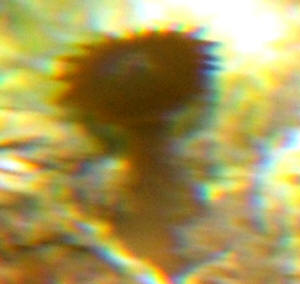 |
|
Zoanthid ID & juvenile angel & eel ID
3/8/2010
Hey Crew !!!
<Hey Abdo!>
Abdo here, from the land of the pharaohs :D (AKA aquarium no
man's land!!!)
<Ahh, hope to be diving w/ friends in Sharm this coming
May>
First I just want to show my deeeeep gratitude for you guys being
there,
really makes the difference !!! from the bottom of my heart:
THAAAAAAANK YOUUUUUUUU
<Welcome>
now down to business
I have just ventured into invertebrates and I'm having a hard
time identifying that group of polyps I just bought, the tank
they were in at the retailer's was such a biohazard that a
military submarine wouldn't survive !!!
<Heeee!>
anyway I attached a picture, it was taken the day after I put
them in the tank, they were acclimated very slowly over 4 hours
and now I think 80% of them have opened completely :D Yay :D Hope
you guys could help me treat the polyps well :)
<Looks to be some species of Zoanthid; very nice>
Another question, hope I'm not being a pain in the neck
here......
I bought what I identified positively as a vermiculated angel, at
just under an inch long!!!, do you have any special
recommendations regarding such a fish, given its size and other
tank inhabitants ??? any advice ???
<Mmm, yes... keep it with small-ish, easygoing fishes,
non-predatory invertebrates and you should be fine. These angels
grow quite quickly when small, given good circumstances>
lastly (I promise), I had bought those 2 eels a while ago, and
I've been having such a hard time identifying them it drives
me crazy !! their looks are not special but their behavior amazes
me!! They are grey with white bellies, 30cm long with 1cm
diameter or so, small eyes, dotted lateral line near the head and
curved, burrow under the sand and they do it backwards, meaning
they stick their tails in and slip into the sand bed, and once
they grab a piece of food they quickly pull it down under the
sand to eat it, the retailer said they we're from the red
sea, but I wouldn't count on anything he says.
the closest matches I could find in Dr. Burgess's atlas of
marine aquarium fishes were "Pisodonophis cancrivorus"
and "Muraenichthys tasmaniensis" but I'm not so
sure..... I attached the best picture I could take, hope it
helps.
<Mmm, is an Ophichthid... a Snake Eel... looks a bunch like an
Apterichthys species... Unfortunately I don't see this
species in my in-print reference works, and Fishbase.org is
running VERY slowly currently. I would go there, and search
"By Country" (I did for Jordan), Marine fishes (which
will come out by default by species) and re-sort by family...
Look at the Ophichthids found there (the Red Sea)... and try to
find these species for photos, further descriptions>
I have a 110G + 20G sump, since August 2008, sandy bottom with
one pile of LR, some locally obtained Ulva, 2 four stripe
damsels, 1 domino, 1 silver moony, 1 Aidablenius sphynx, many
coastal shrimps, 1 vermiculated angel, 1 common goby, 1 red
tomato, 1 urchin with short sharp spines (red sea), several
mussels and oysters, some Nerites, the 2 eels and the clump of
Zoas.
<Sounds very nice indeed!>
Thank you in advance, and sorry for the long email :S
<Thank you for sharing! Bob Fenner>
|
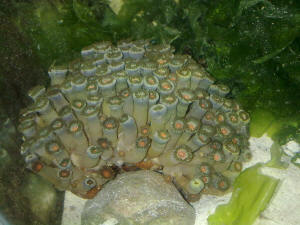 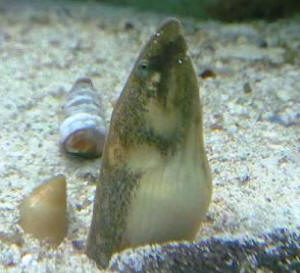 |
|
Can You Please Help Me Identify? Likely Protopalythoa
-- 2/5/10
Hi Guys,
<Hello George, Lynn here today.>
Thanks for the great site and help.
<Always a pleasure.>
I just bought a Nano 34 gallon and found these guys on some of
the LR. I can't tell if it is Aiptasia or hydroid Myrionema
or something else.
<Thankfully, it's neither. It appears to be a nice little
group of Zoanthids, likely Protopalythoa, aka button polyps.
Please see the following links for more information:
http://www.wetwebmedia.com/zoanthid.htm
http://www.wetwebmedia.com/ca/volume_1/cav1i1/blane-zoanthids/zoanthids.htm
Be sure to check out Bob's terrific photos at this link for
comparison:
http://www.wetwebmedia.com/Pix%20Of%20The%20Day%20Marine/POTD%20SW%20Arch%20120-149/swpotdarch148.htm
>
Thanks
<You're very welcome.>
George
<Take care, LynnZ>
|
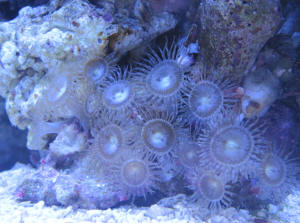 |
|
Aiptasia? 11/3/09
Hi Crew!
<G>
I looked over the FAQ's on identifying Aiptasia, and found
some previous posters pictures that looked similar, that you
confirmed or thought were Aiptasia, and some that looked similar
that were identified as not being Aiptasia. I would really like
to know for certain if I should "yank" these guys from
the tank.
<Mmm, I wouldn't... Looks to be a good deal of space for
them here...>
I believe they are all still attached to the half shell you see
there, so they would be easy to eliminate at this point. Thanks
in advance, your site is awesome!
Greg
<These are Zoanthids. Bob Fenner>
|
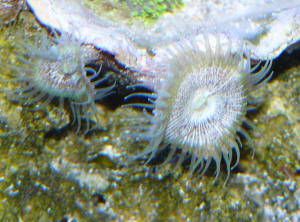 |
|
Question About My Zoanthids/Zoanthid Behavior, ala
Salty 11/11/09
Good evening coral gurus
<Hello George>
- my first time for a question. I have 60 gal reef tank with some
long time (18 months) colonies of Zoanthids which were primarily
brown center with green tentacles. Colonies have grown nicely
over time. However more recently I am experiencing more of the
polyps becoming a "washed out brown" color and they
appear to be "stretching or reaching" out a. As a
result the real colorful polyps appear to be smothered out or
disappearing. Lighting is 2 -150W 14,000K HQI's. Any ideas as
to why this is happening? Picture attached. It's like I
almost want to take a colony and give it a haircut and trim these
off (LOL), but I know that's not the answer.
<Zoanthids can and will change color given differing
conditions and/or in the presence of competing
Cnidarians.>
Thanks,
<You're welcome. James (Salty Dog)>
George T
Question About My Zoanthids, RMF's go
11/11/09
Good afternoon gurus - first time for a question. I have 60 gal
reef tank with some long time (18 months) colonies of Zoanthids
which were primarily brown center with green tentacles. Colonies
have grown nicely over time.
However more recently I am experiencing more of the polyps
becoming a "washed out brown" color and they appear to
be "stretching or reaching" out a. As a result the real
colorful polyps appear to be smothered out or disappearing.
Lighting is 2 -150W 14,000K HQI's. Any ideas as to why this
is happening? Picture attached. It's like I almost want to
take a colony and give it a haircut and trim these off (LOL), but
I know that's not the answer. Thanks
George T
<Hello George. Well, first off I'll mention that this is
apparently two (competing) varieties, likely species of
Zoanthids... w/ as you state, the more somber one overtaking the
prettier. Next I really want to stress that
these animals are VERY toxic to other life, including humans. You
MUST be extremely careful in handling them... keeping the
"juice" out of your eyes, face, off your skin period.
If you are still inclined to try separating the colonies, please
read here:
http://wetwebmedia.com/zoanthidcompfaqs.htm
and the linked files above. Do take care, Bob Fenner>
|
 |
Re: Question About My Zoanthids/RMF
11/11/09
Thanks - will read before attempting surgery!
George Trauten
<Welcome and good. As you'll find, too many folks have had
very bad results... Cheers, BobF>
Re Question About My Zoanthids/Zoanthid Behavior/James
11/11/09
Thanks and yes I understand there might be changes that can alter
the display of the animals. One thing is that my lights are now
about eight months old - could that be a reason?
<Possibly, but unlikely. I have the same thing going on with one
of my colonies and I have new lamps.>
And could I trim the colony back some without causing damage to the
colony?
<You could, and you may cause some damage near the trim area but
will soon heal. Best tool I've found is an Exacto knife with a
#11 blade.>
Thanks Salty Dog!
<You're welcome. James (Salty Dog)>
Re Question About My Zoanthids/Zoanthid Behavior
11/11/09
Got it - will do some surgery and clean up the colony!
<Sounds good. James (Salty Dog)>
George T |
|
|

